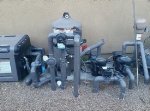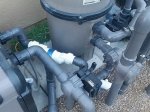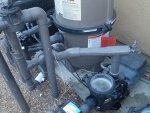Flow Meter
- Thread starter booboo
- Start date
You are using an out of date browser. It may not display this or other websites correctly.
You should upgrade or use an alternative browser.
You should upgrade or use an alternative browser.
Wow, that is a tight squeeze! I don't think I would try to get a flow meter in there. It really doesn't tell you much. You want to have enough flow to to make your SWG happy and not get a low flow error and enough flow to skim your pool surface. For my VS pump I started at 900 rpm but got low flow error as the filter got dirty, tried 1000 and it was better but still got them occasionally. Ended up at 1100 rpm which uses 150 watts, never gives me a low flow error and does a good job skimming the leaves.
Well, if you had a Jandy style check valve, you could easily put in a TFTestkits.net as show here. I have the one on the upper right.
I think I am going to put it right after the pump. If you look at the third photo it will be in the horizontal PVC pipe just over the pump basket.
Anyone have a suggestion were to put the flow meter?
If I start the pump at full speed and back the RPMs down until the flow rate starts to drop. Is that the most efficient RPM for the pump to run at?
If I start the pump at full speed and back the RPMs down until the flow rate starts to drop. Is that the most efficient RPM for the pump to run at?
Why do you need a flow meter? Do I recall from another thread that you are adding solar?
You last question makes no sense as the flow rate and pump speed are related. The flow rate will always drop as you lower the pump speed. The most efficient speed is down around 1000rpm, but that is often too low for some applications.
You last question makes no sense as the flow rate and pump speed are related. The flow rate will always drop as you lower the pump speed. The most efficient speed is down around 1000rpm, but that is often too low for some applications.
Why do you need a flow meter? Do I recall from another thread that you are adding solar?
You last question makes no sense as the flow rate and pump speed are related. The flow rate will always drop as you lower the pump speed. The most efficient speed is down around 1000rpm, but that is often too low for some applications.
My signature states 9 solar panels. I am installing 6 more next week so I will have 15 panels.
Wont the flow rate max out at a certain RPM. If you run the pump over that RPM the flow rate stays the same but the power consumption increases. That makes me think that if you start at full speed (RPM) you be at the max flow rate. If you decrease the RPM a little at a time until the flow rate drops you can determine the most efficient RPM. Is this correct?
- Jun 12, 2011
- 3,763
- Pool Size
- 19500
- Surface
- Plaster
- Chlorine
- Salt Water Generator
- SWG Type
- Pureline Crystal Pure 60,000
I have a flow meter that I installed when I added the VS pump. I referred to it a bit at first in setting up my pump programming, but never look at it anymore. As far as the solar panels I just set my pump a few hundred rpm above the minimum required to keep the air relief valve closed. That seems to work well for me.
I have 12 4x12.5 Heliocol panels on the roof and when the solar heat comes on the pump Ramps up to 2,400 rpm (750 watts). A local Heliocol tech was here recently for a leak, and confirmed that setup was working fine.
I have 12 4x12.5 Heliocol panels on the roof and when the solar heat comes on the pump Ramps up to 2,400 rpm (750 watts). A local Heliocol tech was here recently for a leak, and confirmed that setup was working fine.
- May 3, 2007
- 16,886
- Pool Size
- 20000
- Surface
- Plaster
- Chlorine
- Salt Water Generator
- SWG Type
- Hayward Aqua Rite (T-15)
No, this is not correct. Flow rate is directly proportional to RPM. There is no fundamental limit to flow rate through plumbing. The max flow rate is determined by the pump head curve and the plumbing curve cross over point.Wont the flow rate max out at a certain RPM. If you run the pump over that RPM the flow rate stays the same but the power consumption increases. That makes me think that if you start at full speed (RPM) you be at the max flow rate. If you decrease the RPM a little at a time until the flow rate drops you can determine the most efficient RPM. Is this correct?
No, this is not correct. Flow rate is directly proportional to RPM. There is no fundamental limit to flow rate through plumbing. The max flow rate is determined by the pump head curve and the plumbing curve cross over point.
The pump I have is a Hayward EchoStar VS 3400. I was told that this pump will operate more efficient at a lower RPM than full speed. I was also told that using a flow meter will allow me to determine the most efficient speed. Is this not true?
It is true that it will be more efficient at lower speed. Most 2 speed pumps move 1/2 the water volume using 1/4 of the power on low vs high speeds. The same curve applies to VS pumps although I don't know the ratio. Gallons pumped per watt will be higher at lower pump speeds.
My VS pump moves plenty of water for skimming and making chlorine at 1100 rpm and only uses 150 watts of electricity. For solar it runs at 1950 rpm and moves substantially more water and uses 550 watts. At 2500 rpm is uses 1150 watts. It does not seem like it pumps twice as much water at 2500 rpm as it does at 1950 rpm even though it is using twice as much electricity.
Yes, I do suppose if you had a flow meter you could set up a spreadsheet to calculate the most gallons pumped per watt to determine the most efficient pump speed. But, that seems like a lot of effort when that flow rate might not be right for your application. And gut feel and low flow sensors for heaters, SWGs, etc will get you close enough. For solar you want your panels to be relatively cool to the touch and the water coming in to the pool not to be too warm. The cooler the panels are to the touch the more heat the water is transferring and taking to the pool. This is more important than a certain gallon per minute flow rate or a certain pump efficiency.
My VS pump moves plenty of water for skimming and making chlorine at 1100 rpm and only uses 150 watts of electricity. For solar it runs at 1950 rpm and moves substantially more water and uses 550 watts. At 2500 rpm is uses 1150 watts. It does not seem like it pumps twice as much water at 2500 rpm as it does at 1950 rpm even though it is using twice as much electricity.
Yes, I do suppose if you had a flow meter you could set up a spreadsheet to calculate the most gallons pumped per watt to determine the most efficient pump speed. But, that seems like a lot of effort when that flow rate might not be right for your application. And gut feel and low flow sensors for heaters, SWGs, etc will get you close enough. For solar you want your panels to be relatively cool to the touch and the water coming in to the pool not to be too warm. The cooler the panels are to the touch the more heat the water is transferring and taking to the pool. This is more important than a certain gallon per minute flow rate or a certain pump efficiency.
pooldv, How did you figure out at what rpm to run your solar? 1950 rpm is kind of specific sounding. 
- May 3, 2007
- 16,886
- Pool Size
- 20000
- Surface
- Plaster
- Chlorine
- Salt Water Generator
- SWG Type
- Hayward Aqua Rite (T-15)
Yes the pump will operate more efficienty at low speed but I was commenting the following that was not true.The pump I have is a Hayward EchoStar VS 3400. I was told that this pump will operate more efficient at a lower RPM than full speed. I was also told that using a flow meter will allow me to determine the most efficient speed. Is this not true?
Wont the flow rate max out at a certain RPM (yes full speed). If you run the pump over that RPM the flow rate stays the same(No, flow rate continues to go up) but the power consumption increases. That makes me think that if you start at full speed (RPM) you be at the max flow rate. If you decrease the RPM a little at a time until the flow rate drops you can determine the most efficient RPM. Is this correct?
The most efficient speed for the EcoStar is around 1000 RPM.
Id have to agree with the guys on this, you have very little straight run, flow meters to be accurate typically have to have a certain ratio of distances before and after an elbow. For a 1.5" pipe is like 15 or sixteen inches before and like 6-8 inches after depending on the manufacturers guidelines. Ignore this and you wont get anything or at least anything accurate. Also should be on the return side of the filter. If you had influent and effluent pressure gauges at the pump, you could use the pump curve of your model to determine your flow. A summer club in consult for has to do this on their baby pool and I had to get permission from the health department to use this because of the situation.
FlowVis® Flow Meters do not need long straight pipe runs (unlike other flow meters). See Section 8 Installation in this manual showing that it can be installed right next to an elbow since it is not affected by flow stream disturbances.
pooldv, How did you figure out at what rpm to run your solar? 1950 rpm is kind of specific sounding.
Well, it isn't 1956! :-D like that other thread! I was just upping it by 50 rpm until it seemed good and that is where it landed. I get good solar heating and low power consumption! Double winner!
Well, it isn't 1956! :-D like that other thread! I was just upping it by 50 rpm until it seemed good and that is where it landed. I get good solar heating and low power consumption! Double winner!
About the only thing I could tell with my solar heating was that running it at around 2000 rpm, the returns were noisy and bubbly and that just didn't seem right. I think around 2200 they quieted so I set it at 2300 and called it good. Are your panels on a second story roof? Mine are. It is probably getting close to 30 feet to the top tube of the solar return pipe. Looking at various pump curves for the IntelliFlo 011018 and using 30' of head, 2000 and up looked like a good region to run my pump at. Also, my filter gauge reads about 15 psi (clean cartridges) at this 2300 clip. It was recommended to me by a Pentair tech to run the pump at that PSI for solar panels on a second story roof so it all seems good. When I close off the pool (no solar), he said running it at 5 psi should be plenty. That comes out to around 1500 rpm last I checked for my system.
FlowVis® Flow Meters do not need long straight pipe runs (unlike other flow meters). See Section 8 Installation in this manual showing that it can be installed right next to an elbow since it is not affected by flow stream disturbances.
This flow meter is a bit spendy but it is dead simple to install assuming you have a Jandy check-valve. As Richard posted, they can be installed anywhere you have a check valve. Pretty slick little device.
Thread Status
Hello , This thread has been inactive for over 60 days. New postings here are unlikely to be seen or responded to by other members. For better visibility, consider Starting A New Thread.
Similar threads
- Replies
- 1
- Views
- 69
- Replies
- 7
- Views
- 73
- Replies
- 24
- Views
- 393
- Replies
- 5
- Views
- 283




